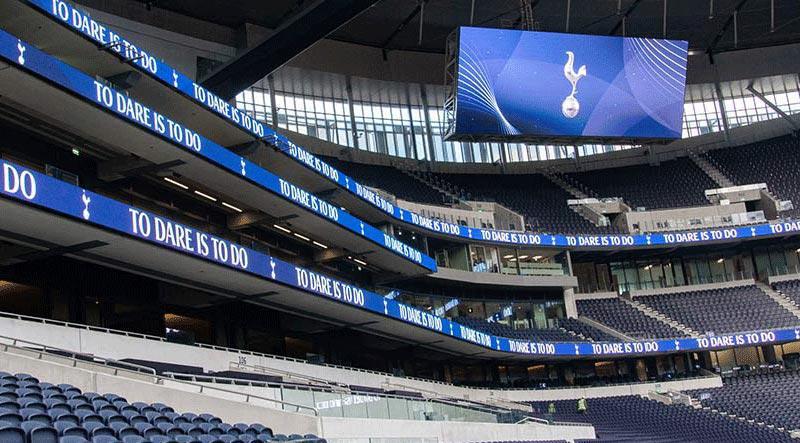As LED display technology continues to evolve, more and more stadiums are installing LED displays. These displays are changing the way we watch games in stadiums, making the viewing experience more interactive and lively than ever before. If you are considering installing LED displays in your stadium or gym, we hope this blog has helped you.
What Are LED Displays for Stadiums?
Stadium LED screens are electronic screens or panels designed specifically for these venues and are intended to provide rich visual content and information to viewers. Using advanced LED technology, these screens are capable of generating high-resolution and vibrant visual effects that can be easily seen by distant viewers, even in bright sunlight. They feature high brightness and strong contrast to ensure clear and vivid images in a variety of environments. In addition, these displays are carefully designed for durability and weatherproofing to withstand the impact of outdoor environments and sporting events. These LED displays come in a variety of sizes and shapes, from small scoreboards to huge video walls covering multiple areas.

LED displays are capable of showing live video of the game, replays of highlights, information on fair penalties, advertisements, sponsor information and other promotional content, providing viewers with a high-definition visual experience. With remote control and real-time updates, LED displays have the flexibility to show scores, statistics and other information, adding even more excitement to modern sporting events. Additionally, LED displays can enhance the overall viewing experience by showcasing interactive content, fan engagement activities, and entertainment elements, especially during breaks between games.
Features and Advantages of LED Display in Stadiums

1. High Resolution
Stadium LED displays support resolutions from 1080P to 8K and can even be customized. The high resolution shows more details and ensures that viewers in every seat experience the ultimate in visual impact and clarity.
2. High Brightness and High Contrast Ratio
These LED screens offer high brightness and high contrast to ensure clear, vivid images in a variety of environments. Whether in bright daylight or in varying ambient light, viewers can easily watch the screen content.
3. Wider Viewing Angles
Stadium LED displays offer a viewing angle of up to 170 degrees, ensuring a consistent and high-quality viewing experience no matter where the audience is in the stadium. This wide viewing angle allows more people to enjoy the content at the same time.
4. High Refresh Rate
The high refresh rate ensures smooth, clear and seamless visuals, especially for fast-moving sports content. This helps reduce motion blur and allows viewers to more accurately capture the excitement of the game. A refresh rate of 3840Hz or even 7680Hz is often required to meet the demands of real-time video broadcasting, especially during large-scale sporting events.
5. Dynamic Content Management
The Dynamic Content Management feature allows for real-time updates, enabling the display of live scores and instant replays, enhancing fan engagement while providing opportunities for interactive experiences that connect viewers more closely to the event.
6. Customization
Customized LED displays offer innovative revenue opportunities and can create dynamic landmark venues that attract and engage fans. These creative LED displays can be set up with a variety of features such as advertising zones, team branding, live interactive video and playback, and more.
7. Waterproof and Ruggedness
The waterproof and rugged construction of the LED screen allows it to withstand a wide range of weather conditions, ensuring reliable operation during outdoor events. This durability allows LED screens to maintain excellent performance in a variety of environments.
8. Quick Installation and Maintenance
Stadium LED displays are usually modular in design, and the modular panels can be flexibly spliced together to suit the needs of different venues. This flexibility not only simplifies the installation process, but also enables it to be completed in a short period of time, bringing higher efficiency to the stadium. In addition, the modular design makes repairing or replacing damaged panels quick and easy.
9. Advertising Capacity
Stadium LED displays can also be used as advertising screens. By displaying advertising content, sponsors are able to promote their brands in a more targeted manner and reach a wider audience. This form of advertising not only has a higher visual impact, but also has the flexibility.
Factors to Consider When Buying Stadium LED Display

1. Screen Size
The size of the screen directly affects the choice of resolution. A larger screen can provide a better viewing experience, especially for viewers sitting farther away, where clear and vivid images can better attract their attention.
2. Installation Method
The installation location will determine how the LED display is installed. In a sports stadium, you need to consider whether the screen needs to be ground mounted, wall mounted, embedded in the wall, fixed to a pole, or suspended, and ensure that it supports front and rear maintenance to facilitate subsequent installation and maintenance work.
3. Control Room
It is very important to know the distance between the screen and the control room. We recommend using a "synchronous control system" and a powerful video processor to control the LED display in the stadium. This system requires cables to be connected between the control hardware and the screen to ensure that the screen works properly.
4. Cooling and Dehumidification
Cooling and dehumidification are crucial for large LED displays. Excessive heat and high humidity can cause damage to the electronic components inside the LED screen. Therefore, it is recommended to install an air conditioning system to maintain a suitable working environment.
Post time: Oct-31-2024







